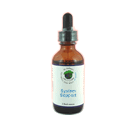|
|
Bone Support Remedy
 |
Bones give shape to structures such as the head, face, thorax and limbs. They also provide support and protection. For example, the bones of the skull protect the eyes, ears and brain. All of the bones together represent your skeletal system. In an adult, the skeleton comprises around twenty percent of the total body weight. The skeleton is the site of haematopoiesis, which takes place in red bone marrow.
Bone matrix can store calcium and is involved in calcium metabolism, and bone marrow can store iron in ferritin and is involved in iron metabolism. However, bones are not entirely made of calcium, but a mixture of chondroitin sulfate and hydroxyapatite, the latter making up 70% of a bone.
Bone cells release a hormone called osteocalcin, which contributes to the regulation of blood sugar (glucose) and fat deposition. Osteocalcin increases both the insulin secretion and sensitivity. It also boosts the number of insulin-producing cells and reduces storage of fat. Your bones have small blood vessels and lymphatic tissue for the maintenance and repair of bone tissue.
Fun Facts
- When you were born you had over 300 bones. As you grew, some of these bones began to fuse together and as an adult you have 206 bones.
- The longest and heaviest bone in the body is the femur found in the upper part of your leg.
- The smallest bone is the stapes bone in the middle ear.
Health Conditions
- Osteoporosis occurs when there is not enough calcium in the bloodstream so the body attempts to pull calcium from the bones, which thins and weakens them.
- Osteogenesis imperfecta is a genetic defect that affects how you make collagen, which is what makes bones strong so bones break easily.
- Rickets (which affects children) and osteomalacia (which affects adults) is a weakness of bones where they break down faster than they can form because of an imbalance in calcium or vitamin D.
- Renal Osteodystrophy happens when chronic kidney disease causes stimulation of bone metabolism caused by an increase in parathyroid hormones, and by a delay in bone mineralization that is caused by decreased kidney production of 1,25-dihydroxyvitamin D.
- Paget's disease of bone is a progressive, often crippling disorder of bone remodeling that commonly involves the spine, pelvis, legs, or skull (although any bone can be affected).
- Osteogenesis Imperfecta (OI) causes bones to be weak and break easily; this condition is also known as brittle bone disease.
- Bone tumors can originate in the bone (these are known as primary tumors) or more commonly, result from the seeding of bone by tumors outside of the skeleton (these are known as metastatic tumors, since they have spread from somewhere else). Both types of tumors can destroy bone, although some metastatic tumors can actually increase bone formation.
Suggestions To Strengthen
- Limit sugar, sweet drinks, processed foods, tea and coffee as they all strip magnesium, calcium and vitamin C from the body. All of these elements are vital for the formation and repair of bone, muscle, cartilage and synovial fluid.
- In order for bones to be healthy, the kidneys must be healthy and there must be adequate levels of Vitamin D3 in the body (even more important than calcium in most cases). Consider adding these to your Bone Support program.
|
|
| |
Bone Support Remedy
Complete support remedy for Bone and related functions
$14.95
Read/Write Reviews
|
 Add
To Cart Add
To Cart |
 |
 |
Kidneys Support Remedy
Complete support remedy for Kidneys and related functions
$14.95
|
 Add
To Cart Add
To Cart |
 |
 |
Parathyroid and Parotid Support Remedy
Complete support remedy for Parathyroid and Parotid and related functions
$14.95
|
 Add
To Cart Add
To Cart |
 |
 |
Vitamin D3
A must for bones, hormone and sleep.
$19.95
|
 Add
To Cart Add
To Cart |
 |
 |
|
|




